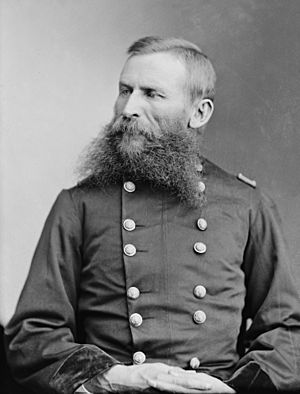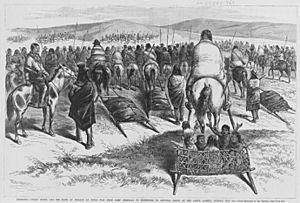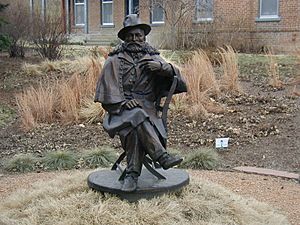George Crook facts for kids
Quick facts for kids
George Crook
|
|
|---|---|

Portrait of George Crook
|
|
| Nickname(s) | Nantan Lupan, which means "Grey Wolf" |
| Born | September 8, 1828 Taylorsville, Ohio, US |
| Died | March 21, 1890 (aged 61) Chicago, Illinois, US |
| Place of burial | |
| Allegiance | United States of America Union |
| Service/ |
United States Army Union Army |
| Years of service | 1852–1890 |
| Rank | |
| Commands held | 36th Ohio Volunteer Infantry Regiment Kanawha Division Army of West Virginia Arizona Territory Department of the Platte Department of the West Division of the Missouri |
| Battles/wars | |
| Spouse(s) | Mary Tapscott Dailey |
| Signature | |
George R. Crook (born September 8, 1828 – died March 21, 1890) was an important officer in the United States Army. He is best known for his work during the American Civil War and the Indian Wars. The Apache people gave him a special nickname, Nantan Lupan, which means "Chief Wolf."
Contents
Early Life and Military Beginnings
George Crook was born on a farm in Taylorsville, Ohio. He went to the United States Military Academy, also known as West Point, and graduated in 1852.
After West Point, Crook served in California and Oregon from 1852 to 1861. He worked to protect or sometimes fight against different Native American tribes. During the Pitt River Expedition in 1857, he was badly hurt by an arrow. He even helped set up a fort in California that was later named after him.
Crook became very skilled in hunting and wilderness survival during these years. He often learned from the Native Americans, even picking up some of their languages. These skills helped him greatly in later battles. He was promoted to first lieutenant in 1856 and captain in 1860.
Civil War Service
Joining the Fight
When the American Civil War began, Crook became a colonel of the 36th Ohio Infantry regiment. He led his troops in western Virginia. He was wounded in a small fight at Lewisburg.
Crook and his regiment later joined the Kanawha Division. He fought at the Battle of South Mountain and the Battle of Antietam. He was promoted to brigadier general in September 1862. During these early battles, he became good friends with Colonel Rutherford B. Hayes, who later became a U.S. President.
After Antietam, General Crook took command of the Kanawha Division. He later led an infantry brigade in the Army of the Cumberland. He fought in the Battle of Hoover's Gap and the Battle of Chickamauga. In 1864, he returned to lead the Kanawha Division, which was now part of the Army of West Virginia.
Campaign in Southwest Virginia
In spring 1864, Lieutenant General Ulysses S. Grant ordered General Crook to attack the Virginia and Tennessee Railroad. This railroad was important for the Confederate capital, Richmond. Crook's mission was to destroy the railroad and a bridge over the New River.
Crook's force of about 6,500 men marched through difficult, mountainous terrain. Spring rains made the roads muddy and hard to travel. On May 9, 1864, Crook's troops faced Confederate forces at Cloyd's Mountain. The Union soldiers charged across a meadow and a creek, fighting hand-to-hand.
General Crook himself had trouble crossing the creek because his tall boots filled with water. Soldiers had to pull him to the other side. The Union forces won the battle, capturing many Confederate soldiers. After the victory, Crook's men destroyed the railroad and the New River bridge.
Shenandoah Valley Battles
In July 1864, Crook took command of a group called the Army of the Kanawha. He was defeated at the Second Battle of Kernstown. However, he was soon given command of the Department of West Virginia. His army later joined Philip H. Sheridan's Union Army of the Shenandoah.
Crook led his troops in the Valley Campaigns of 1864. He fought in battles like Opequon, Fisher's Hill, and Cedar Creek. In October 1864, he was promoted to major general.
In February 1865, Confederate raiders captured General Crook. He was held as a prisoner of war in Richmond for a month. After being exchanged, he returned to command a cavalry division. He played a key role in the final battles of the war, including Five Forks and Appomattox Court House.
Indian Wars Campaigns
After the Civil War, George Crook continued his military career. He was promoted to lieutenant colonel and served in the Pacific Northwest. In 1867, he became head of the Department of the Columbia.
Fighting the Snake Indians
Crook successfully led campaigns against the Snake Indians in the Snake War (1864-1868). He had fought Native Americans in Oregon before the Civil War. He used new tactics, like attacking during the winter when tribes were gathering food. He also used Native American scouts to find enemy camps.
In 1867, Crook's scouts found a Paiute village near Steens Mountain. Crook's forces attacked, causing heavy losses for the Paiute. He later defeated a group of Paiute, Pit River, and Modoc people at the Battle of Infernal Caverns.
Yavapai War Victories
President Ulysses S. Grant put Crook in charge of the Arizona Territory. Crook used Apache scouts during his Tonto Basin Campaign. This helped him succeed in moving the Yavapai and Tonto Apache people onto reservations. His victories included the Battle of Salt River Canyon and the Battle of Turret Peak.

In 1873, Crook was promoted to brigadier general in the regular army.
Great Sioux War Engagements
From 1875 to 1882, Crook was in charge of the Department of the Platte. His headquarters were at Fort Omaha in North Omaha, Nebraska.
Battle of the Rosebud
On June 17, 1876, General Crook led a force of over 1,000 soldiers and 261 Shoshone and Crow allies. They were marching north along Rosebud Creek. The Crow and Shoshone scouts sensed that enemy Native Americans were nearby.
Around 8:30 AM, the Sioux and Cheyenne attacked Crook's Indian allies. The scouts fought bravely, giving Crook time to get his soldiers ready. The battle was intense, and Crook's troops used a lot of ammunition. Because of low ammunition and many wounded soldiers, Crook decided to return to his base.
Some historians wonder if Crook's actions that day could have changed the outcome of the Battle of the Little Bighorn, where George Armstrong Custer's troops were defeated.
Battle of Slim Buttes

After the Little Bighorn disaster, the U.S. Army wanted to show they could still fight the Sioux. Crook led a difficult march where soldiers had to eat their horses and mules because supplies ran out. On September 9, 1876, a supply party found the village of American Horse the Elder. The village was attacked and looted in the Battle of Slim Buttes. Crazy Horse led a counter-attack the next day, but Crook's larger force pushed them back.
Standing Bear v. Crook
In 1879, General Crook spoke up for the Ponca tribe and Native American rights. This happened during a famous court case called Standing Bear v. Crook. The judge decided that Standing Bear had some of the same rights as U.S. citizens.
Geronimo's War
Crook became head of the Department of Arizona. He managed to get some Apache groups to surrender, but Geronimo kept avoiding capture. The Apache respected Crook and called him Nantan Lupan, meaning "Chief Wolf." In March 1886, Geronimo agreed to meet Crook for talks. A photographer named C. S. Fly took pictures of Geronimo and his group during these talks. These are the only known photos of an American Indian still at war with the United States.
Geronimo agreed to surrender. However, that night, a soldier told Geronimo's group that they would be killed if they crossed the border. Geronimo and 25 followers escaped. This escape cost Crook his command.
Nelson A. Miles replaced Crook in 1886 and eventually captured Geronimo. Miles also imprisoned the Chiricahua Apache scouts who had helped the U.S. Army. Crook was very angry about this, as these scouts had served faithfully. He protested their imprisonment, but they, along with most of Geronimo's band, were held captive for 26 years.
After many years of fighting in the Indian Wars, Crook was promoted to Major General. In 1888, President Grover Cleveland put him in charge of the Military Division of the Missouri.
Later Life and Legacy
General Crook spent his last years speaking out against the unfair treatment of Native Americans. He died suddenly in Chicago in 1890. He was first buried in Oakland, Maryland, but his remains were later moved to Arlington National Cemetery in 1898.
Red Cloud, a war chief of the Oglala Lakota (Sioux), said about Crook, "He, at least, never lied to us. His words gave us hope."
Honoring General Crook

Crook's good friend, Rutherford B. Hayes (who became President), named one of his sons George Crook Hayes in his honor.
Many places are named after him:
- Crook Counties in Wyoming and Oregon.
- The town of Crook, Colorado.
- "Crook City" and Crook Mountain in South Dakota.
- Crook Peak in Lake County, Oregon.
- Crook Mountain in the North Cascades.
- The "General Crook Trail" (Forest Road 300) in Arizona, which was a military supply road.
- Fort Crook (1857–1869) in California.
- Fort Crook (1891–1946) in Nebraska, now part of Offutt Air Force Base.
The 3rd Brigade Combat Team, 1st Cavalry Division is nicknamed "Greywolf" in honor of his Apache nickname. The General Crook House at Fort Omaha and Crook House at Fort Huachuca are also named after him.
In Popular Culture
George Crook has been shown in movies and TV shows:
- In the 1993 movie Geronimo: An American Legend, he was played by Gene Hackman.
- He was a character in the TV series Deadwood, played by Peter Coyote.
- He appears in the video game Call of Juarez: Gunslinger as Grey Wolf.




